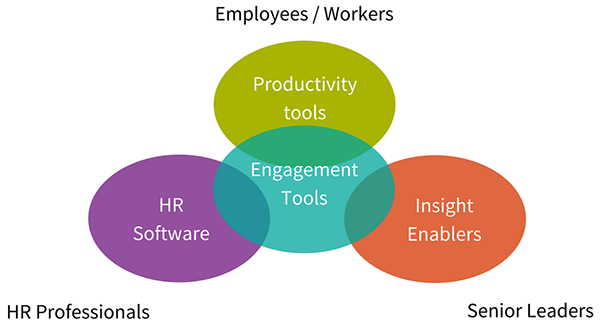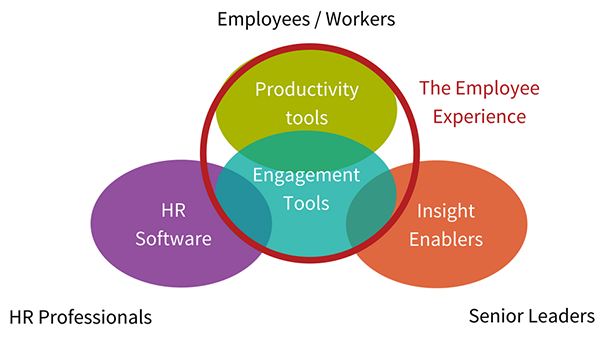Why HR needs to own the technology conversation
In my experience, when you talk to employees about what makes or breaks their positive experience at work, quite often it’s the blockers to them being productive that are often discussed. Having the right tools to do the job, the ability to communicate effectively with others and having a the ability to feedback easily to senior management are top of the list.
Entwined in this are technology enablers. This is a key point for HR. The technology that makes your employees productive (or not!) at work has a large effect on the Employee Experience. So, who owns all this technology when it is so critical to engagement and motivation? Too often this is a decision made without HR involvement which is worrying when it is so important to the positive employee experience.
My recent conversations with HR and business leaders have enabled me to draw a couple of conclusions:
1) Technology doesn’t itself engage people: However, the right technology can enable and accelerate better engagement on the foundations of an established positive workplace culture.
2) The technology landscape that has the potential to disengage is bigger than we often think about in the HR function.
Following some research around these two points, at Tap’d, we have created a model that hopefully will assist HR leaders in dissecting and evaluating the technologies that surround them to assess its suitability for their people. We have called this the HR Tech Ecosystem…
The HR Tech Ecosystem
Within the HR Tech Ecosystem we identified 3 groups of “stakeholders”:
1) The employees
2) HR and line managers
3) Senior leaders
Obviously, groups 2 and 3 are also employees so there will always be overlap. However, the three sets of stakeholders require different outputs from the technology that creates the people experience.
We then identified 4 groupings of technology that have an impact on the people experience within the organisation and therefore are key to employee engagement. This is illustrated below with some explanation:

1) HR Software: This is the majority of the “traditional” HR legacy software from the core HR system to payroll, benefits, recruitment, time and attendance systems etc. Depending on your size of organisation and HR maturity, these systems will probably be in place (even if it might just be an Excel spreadsheet at the moment!).
2) Productivity Tools: This is an interesting area and traditionally has been within the remit of the IT function. For example, the e-mail system and server storage. However, there are a number of key technologies that support much better collaboration that enhance productivity, promote teamwork and create better engagement. These include:
– Personal effectiveness tools such as Trello
– Collaboration and project tools such as Slack, Basecamp
– Bulk information sharing such as Box, Wetransfer
– Integrated applications and connectivity such as Google Apps
3) Engagement Tools: This is a broad category that sits between all stakeholders as these are the conduit for employees and HR/line managers to interact for the betterment of the individual and the organisation:
– Feedback tools: peer to peer recognition, census survey and continuous listening
– Personal Development tools: Self coaching, web-based learning, chatrooms, performance management
– Gamification: creating badges, achievement mechanisms for personal growth and achievement
4) Insight Enablers: The category contains the predictive analytics that can obtain insight from the data of all the other technologies and others within the organisation. The ability to process at speed a number of difference sources of data and compare and contract to identify patterns within your organisation that can result in added-value when acted upon. In the context of employee engagement, patterns of high retention, talent identification and development etc can be spotted and replicated.
With the development and emergence of analytics with NLP (Natural Language Processing) means that you can really start to understand your people in ways impossible only a few years ago.
The “so what?” bit
In our opinion, HR Leaders should be involved in all decisions in all areas of the HR Tech Ecosystem.
HR Leaders can use the HR Tech Ecosystem model to evaluate how their organisations perform in each area.
Furthermore, the two areas of the Productivity and Engagement tools combine together to create the technology that enhances the overall Employee Experience. The Insight Enablers and HR Software solutions are mainly the tools behind the scenes that create the structure for data collection and insight. In our view, too much time is spent reviewing the HR Software only and in isolation at the detriment of those technologies that have more of a direct impact on the motivation and engagement of employees.
Insight Enablers are giving great insight already to HR and business leaders using the data already collected in your organisations through previous surveys, feedback and other data sources. The time is now to step change how simple technology is used in today’s business.

At Tap’d we love having conversations about the topic of the HR Tech Ecosystem and how this fits into your People Journey and HR Maturity. If this article was interesting to you then please contact us now and start the discussion on what you can do to improve the Employee Experience for your people!

